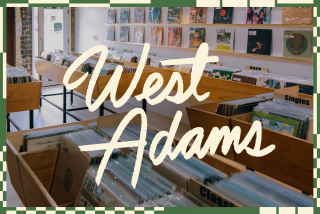St. Elmo Village: A Surrealistic Home to the Art of Living
- Share via
St. Elmo Village is an eruption of art in a regular Los Angeles neighborhood. This community art center is no bastion of culture isolated from its surroundings by white marble walls. It is a collection of bungalows, sheds and garages tied together by a rainbow of colors that seems to have touched every surface. It is a little bit of our city rescued from the isolation of single structures for single families or barracks for groups. It is a place where the community can express itself.
The Village is an active art community made of 10 structures on St. Elmo Drive, just east of La Brea Avenue. Twenty-five years ago, these buildings were just part of the overall pattern of bungalows and apartment buildings that cover most of the great plain of Los Angeles.
Two artists, Rozzell and Roderick Sykes, lived there and gave art classes. When, in 1969, they were threatened by the scourge of all idiosyncrasies, development, they organized their community and managed to buy the property. Soon they were joined by other artists, and as they worked with local children, their little bungalows began to overflow into neighboring structures.
Artists and students alike started painting elaborate abstract patterns on the driveways, picked out parts of the bungalows in greens, yellows and reds, and shaped art objects from found objects. Conifers, succulents and cacti filled every piece of unpaved space, and soon the ramshackle grouping took on the appearance of a little community.
The experience of coming upon St. Elmo Village is almost surreal. It is as if somebody had suddenly placed rose-colored glasses in front of your eyes: You are looking at the regular landscape of Los Angeles, but it has suddenly turned into a dense fabric of textures, colors and shapes. Walk through the complex, and you come across a built fabric of shed roofs, lean-tos, gables, wood walls and garages that all blend into a collage of interconnected spaces. The artisans of the Village have exploited the very standardized, impermanent nature of local building practices to open spaces and forms up to each other. What used to be the rear parking area is now a public space where classes are conducted and artists gather, so that you find a usable communal space in what is usually just a desolate piece of private asphalt.
Behind the former garages, now workshops, small children built a sheltered fish pond by using such found materials as cleaners’ bags. Sitting in this little arbor at the end of the picturesque pathway through the Village, you feel miles away from the bland spaces just out the driveway.
The undisciplined appearance of St. Elmo Village is both its strength and its weakness. Because it imposes no order, it invites invention and participation. Yet the Village is also falling apart, is filled with strange and uncomfortable spaces, and provides few creature comforts. Luckily, the Design Professionals Coalition, a nonprofit group of designers, architects, and engineers, has helped theVillage map out a strategy for upgrading the existing complex and even expanding onto adjacent lots. The Village is looking for funding to carry out the plan. The Gas Co. is pitching in by training local youth to help weatherize the various structures.
You might not find great art at St. Elmo Village, nor will you find great architecture. Instead, you will find that a small piece of the mass-produced and anonymous forms of this city has been taken back by its inhabitants and turned not into an enclosed compound, but an open complex that invites you in. This is a Village that wants you to take part in painting, decorating and otherwise making the forms of the city your own.
Aaron Betsky teaches and writes about architecture.
St. Elmo Village, 4830 St. Elmo Drive, Los Angeles
More to Read
The biggest entertainment stories
Get our big stories about Hollywood, film, television, music, arts, culture and more right in your inbox as soon as they publish.
You may occasionally receive promotional content from the Los Angeles Times.










